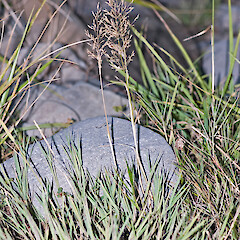Agrostis capillaris
Common name
browntop
Family
Poaceae
Flora category
Vascular – Exotic
Structural class
Grasses
NVS code
The National Vegetation Survey (NVS) Databank is a physical archive and electronic databank containing records of over 94,000 vegetation survey plots - including data from over 19,000 permanent plots. NVS maintains a standard set of species code abbreviations that correspond to standard scientific plant names from the Ngä Tipu o Aotearoa - New Zealand Plants database.
AGRCAP
Conservation status
Not applicable
Habitat
Terrestrial. Plant of coastal, lowland, montane and subalpine habitats (Timmins & MacKenzie 1995). The plant is able to grow on poor soils of low fertility (Timmins & MacKenzie 1995). Plant usually outcompeted on high fertility sites (Timmins & MacKenzie 1995). The plant is prevalent on the heavy soils of the Wairarapa (Hilgendorf 1926). Plant found in scrub and forest margin, both short and tall tussocklands, herbfields, fernlands, sanddunes and river beds (Timmins & MacKenzie 1995). The plant is found in cultivated lands and pasture communities (Hilgendorf 1926).
Wetland plant indicator status rating
Information derived from the revised national wetland plant list prepared to assist councils in delineating and monitoring wetlands (Clarkson et al., 2021 Manaaki Whenua – Landcare Research Contract Report LC3975 for Hawke’s Bay Regional Council). The national plant list categorises plants by the extent to which they are found in wetlands and not ‘drylands’. The indicator status ratings are OBL (obligate wetland), FACW (facultative wetland), FAC (facultative), FACU (facultative upland), and UPL (obligate upland). If you have suggestions for the Wetland Indicator Status Rating, please contact: [Enable JavaScript to view protected content]
FACU: Facultative Upland
Occasionally is a hydrophyte but usually occurs in uplands (non-wetlands).
Detailed description
Tufted perennial grass to 70 cm tall, all parts hairless, dark to bluish-green. Roots with rhizomes, occ stolons. Leaf-blade flat, short and narrow, 100–150 × 1–5 mm; ribs regular, margins slightly rough. Ligule short, membranous and translucent, almost invisible. Leaf-sheath rounded, usually smooth. Emerging leaf rolled. Seedhead open, usually up to 15 cm long with spreading branches, fine, light brown, seeds tiny, brown.
Similar taxa
The plant has delicate feathery brown flower heads about 45 cm tall (Hilgendorf 1926). The plant has slender underground stems that give off numerous shoots and so forms a very close turf under lawn conditions (Hilgendorf 1926).
Flowering
December, January
Fruiting
mid-late April
Year naturalised
1867
Origin
Europe, Temperate Asia
Etymology
agrostis: Greek name for a kind of grass
capillaris: From the Latin capillus ‘hair’ or ‘thread’, meaning hair-like or thread-like
Reason For Introduction
Agricultural
Life Cycle Comments
Perennial. Vegetatively spreading perennial, predominantly outcrossing; tetraplaid (Timmins & MacKenzie 1995).
Reproduction
Sexual and Asexual
Seed
yes (Timmins & MacKenzie 1995).
Dispersal
Seed dispersed by wind, water, humans and vertebrates (Timmins & MacKenzie 1995).
Tolerances
Tolerant of drought and frost, slightly tolerant to shade and poor drainage (Timmins & MacKenzie 1995).
References and further reading
Hilgendorf FW. 1926. Weeds of New Zealand and how to eradicate them. Whitcombe & Tombs Ltd, Christchurch, NZ.







